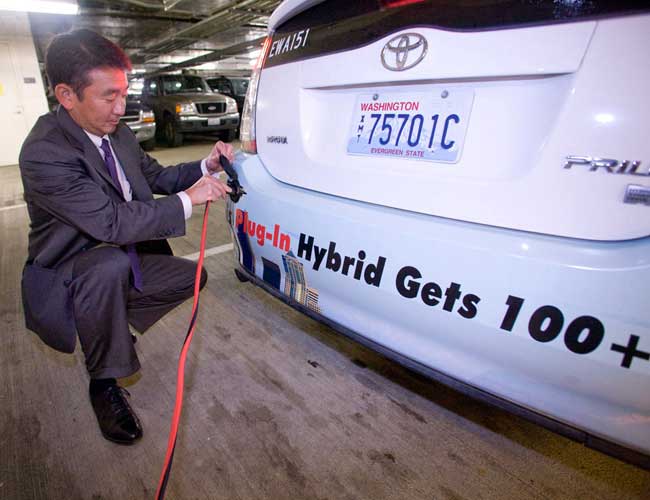Fuel
Transportation-related activities account for roughly a third of all of the county’s greenhouse gas emissions every year. Looking beyond fossil fuels to alternatives fuels, such as a biodiesel or electric, can reduce this impact and lower the county’s carbon footprint. King County has an agreement with its fuel provider to utilize B-5 (5 percent) biodiesel for bulk fuel delivery for Metro Transit and Fleet Administration and the Marine Division is currently using a B-10 blend for water taxi operations. Along with fuel-reducing practices and training, buying cleaner alternative fuels will enable the county to reduce overall fuel consumption and greenhouse emissions.
Policy and Goals:
As stated in King County's Sustainable Purchasing Executive Policy (CON 7-22-EP),
- Increase the percentage of alternative fuels in County fleets 10 percent by 2025
- In its vehicle operations, King County will reduce GHG emissions by 45% by 2025 and 70% by 2030, compared to a 2017 baseline
- Reduce transportation fuel GHG emissions intensities by at least 20% by 2030, compared to 2017 levels
Choose
- biodiesel
- Ultra-Low Sulfur Diesel (ULSD)
- electric or hybrid vehicles
- alternative-fuel conversion kit
- audit current travel practices
- encourage online meetings and conferencing tools when applicable
- purchase third-party certified carbon offsets to compensate for impact
Avoid
- hard acceleration and braking
- excessive idling
- improperly tuned engine
- underinflated tires
- speeding
Types of Fuels
| Alternative Fuel | Description |
|---|---|
| Electric | All-electric vehicles (EVs) use a battery to store the electrical energy that powers the motor. These vehicles can greatly reduce fuel costs and greenhouse gas emissions. |
| Hybrid-Electric | Powered by both gasoline and a battery that recharges as the vehicle brakes. These vehicles can greatly reduce fuel costs and greenhouse gas emissions. |
| Biodiesel (B99-B100) | Biodiesel is an alternative fuel made by reacting animal or vegetable fats with alcohol. Biodiesel refers to the pure fuel before blending with diesel fuel. (80% petroleum diesel, 20% biodiesel blend). |
| Biodiesel (B20) | Biodiesel is an alternative fuel made by reacting animal or vegetable fats with alcohol. Biodiesel refers to the pure fuel before blending with diesel fuel. (80% petroleum diesel, 20% biodiesel blend). |
| Liquefied Natural Gas (LNG) | Natural gas is converted into LNG, by a process called liquefaction, into a clear, colorless liquid. Tailpipe emissions from natural gas vehicles are comparable to those of gasoline and diesel vehicles equipped with modern emissions controls. |
| Ethanol (E85) | Made from corn and other plant materials, which capture carbon dioxide when grown, ethanol is typically blended with gasoline to produce a cleaner-burning fuel. It contains less energy than gasoline, leading to lower fuel economy. |
| Compressed Natural Gas (CNG) | CNG is a readily available alternative to gasoline that’s made by compressing natural gas to less than 1% of its volume at standard atmospheric pressure. Consisting mostly of methane, CNG is odorless, colorless and tasteless. Tailpipe emissions from natural gas vehicles are comparable to those of gasoline and diesel vehicles equipped with modern emissions controls. |
| Propane | Liquefied petroleum gas (LPG) - A gas normally compressed and stored as a liquid, typically used in high-mileage vehicles due to its potential for lower maintenance costs. |
| Hydrogenation-Derived Renewable Diesel | Produced with fats or vegetable oils—alone or blended with petroleum—and refined by a hydrotreating process. Also known as green diesel. |
| Fuel Guidance | |
|---|---|
|
The U.S. Environmental Protection Agency (EPA), U.S. Department of Energy, and U.S. Department of Transportation certify the fuel economy labels for new vehicles sold in the U.S., which outline the vehicle’s fuel economy, fuel cost, greenhouse gas rating, and smog rating. |
| Anti-idling requirements | Employee training and idle reduction equipment conserve fuel when driving. |
|---|---|
| Route optimization | Many software packages and GPS systems exist to help fleets plan their routes more efficiently. |
| Fuel use tracking | Tracking systems record fuel consumption by vehicle and equipment item, helping to identify fuel leaks and inefficient trucks and machinery. |
| Right sizing | Choosing the correct size and type of equipment for the size of the project lowers GHG emissions. |
| Improved maintenance | Proper maintenance of the vehicles, including choosing the correct grade of motor oil and regular tune ups, can reduce fuel use. |
| Ridesharing | Programs promoting carpooling reduces the number of cars on the road and fuel usage. |
| Retrofits | Retrofit technologies, such as diesel particulate filters (DPFs) and diesel oxidation catalysts (DOCs), are products that may be added to further reduce emissions from certified engine configurations. |
| Higher fuel efficient vehicles | Purchasing vehicles with higher miles per gallon ratings reduces fuel needs. |
Technical Specification Language
Sustainable Facilities Tool: Green Procurement Compilation (GPC) Tool and Product Search
U.S. Department of Energy: Alternative Fuels Data Center
California Air Resources Board: Carbon Intensity Lookup table
West Coast Climate & Materials Management Forum: Climate Friendly Purchasing Toolkit
Western Washington Clean Cities: Alternative Fuels
Atlas Public Policy: Fleet Procurement Analysis Tool
Contact Us
Phone: 206-263-9400
TTY Relay: 711
Fax: 206-296-7676

 Translate
Translate
